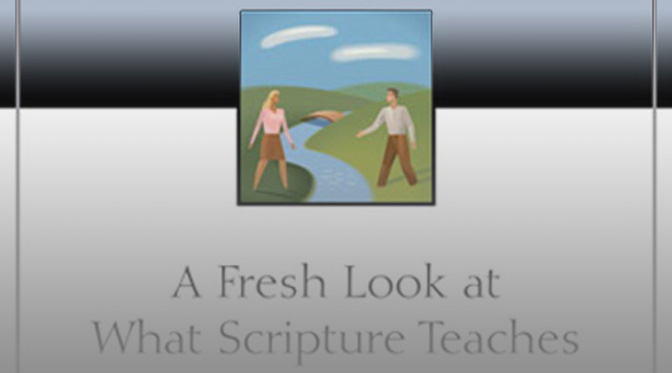Of all the words in the Bible, perhaps one of the most misunderstood in modern times is “adultery”—and if we had to list other misunderstood Bible words, “fornication” would probably rank right up there.
People in our modern society have a different meaning in mind for “adultery” than what the word meant to the Bible’s writers and to its original readers. Also, the meaning of “fornication” is pretty much just as “muddy” in modern minds as well.

In an excellent book titled “Marriage, Divorce, and Remarriage in the Bible“ author and scholar Jay E. Adams shows the original meanings of these words, and sheds light on Scripture verses that are often misunderstood because our modern meanings of the words don’t match the original ones.
The book is only 100 pages long, and well worth its weight in gold. Every Christian should read the book, and especially every minister and/or pastor should read it.
In biblical use and meaning, “fornication” refers to any and all sexual sins (not just “unmarried people having sex” – which is the modern misunderstanding of the term). “Fornication” refers to and includes all types of sexual sin: incest, rape, homosexual acts, lesbian acts, bestiality, any sex act by a person who is not married, and, of course, any sex act by a married person to/with someone other than their spouse.
Also, in biblical use and meaning, “adultery” refers to a sin against a marriage vow (that which violates it, or damages, undermines, or weakens it). Such sins can be “lighter” or “heavier” in the nature of the transgression. Jesus taught that a man simply looking with lust upon a woman who is not his wife, is committing a sin against the marriage vow – Jesus said that lust is adultery. He did not say it was “like” adultery. He said it is adultery. (See Matthew 5:27-28.) For a married person to even flirt suggestively with someone other than their spouse is an act of adultery. Even simply becoming emotionally entangled with someone of the opposite sex other than your spouse is a violation that undermines your vow.
There are many, many ways to sin against a marriage vow. Just to name a few: lying, abuse, abandonment, mind games, inciting jealousy, etc. You get the idea. There are lighter attacks and heavier attacks. However, of all the ways a person can sin against their wedding vow, the worst would be to include the sin of fornication (sexual sin) in the “cheating,” which is actually two sins: adultery by fornication. This is the worst kind of adultery. And it is the only kind that Jesus said could qualify as proper grounds for one believer to divorce another. To wit:
In Matthew 5:32, Jesus said, “But I say unto you, That whosoever shall put away his wife, saving for the cause of _____________, causeth her to commit adultery: and whosoever shall marry her that is divorced committeth adultery.”
If you recite this verse and ask someone to fill in the blank, most people will say “adultery.” But that is not what Jesus said! He said “fornication”!
“But I say unto you, That whosoever shall put away his wife, saving for the cause of fornication, causeth her to commit adultery: and whosoever shall marry her that is divorced committeth adultery.”
By our Lord requiring fornication as grounds, that means not just any act of adultery (such as lusting in the heart, or flirting with someone else, or inciting jealousy, or instances of dishonesty) warrants two believers severing their marriage vow. It has to be that worst kind. However, just because the lighter kinds of adultery are not grounds for divorce does not mean they are not wrong and harmful. Over time, repeated instances of the lighter violations of the marriage vow can slowly destroy a marriage relationship.
While we are at it, another misconception in modern society is that an unmarried person cannot commit adultery (since they are not married). That is simply not true. If an unmarried person has sexual relations with a married person, the unmarried person is sinning against the marriage vow of the other two people who are lawfully married to each other. Both the cheating spouse and the sexually involved unmarried person are committing two sins: adultery and fornication.
As you can imagine, the book contains much more than just these words explained. It is a wonderful resource about marriage and the complicated topics of divorce and remarriage, which are covered in Scripture in much greater detail than many people realize.
Again, I heartily recommend that you get and read this book!
PS: Below is a description of the book from Amazon.com:
“If the church is going to use the Bible to decide whether divorce is legitimate in certain cases and whether divorced couples have the right to remarry with the approval and blessing of God’s people, then the Bible must be studied without prejudice toward a particular answer. The author examines the relevant passages in both the Old and New Testaments so that his readers can consider the many issues and interpretations that arise in trying to establish a consistently biblical position. As a result, readers can see more clearly and accept more firmly the truth of Scripture. The book succeeds at being exactly what the author wanted it to be: ‘a comprehensive, lucid, accurate study presented in a readable and practical style. . . .’ It is a valuable resource for the pastor, counselor, church leader, and others who are struggling to understand and apply scriptural principles to the problems of divorce and remarriage.”

